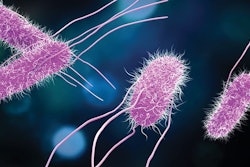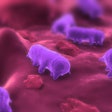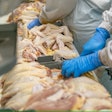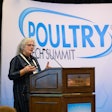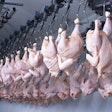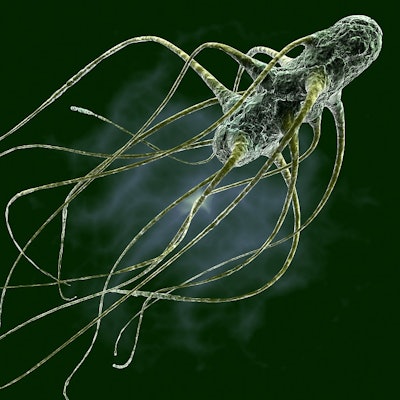
Federal regulators want to focus food safety programs on the most virulent pathogens.
On October 19, 2021, the U.S. Department of Agriculture’s Food Safety and Inspection Service (USDA FSIS) announced a new strategy to reduce Salmonella illnesses associated with poultry products. It is initiating several key activities to gather the data and information necessary to support future action.
“USDA intends to seek stakeholder feedback on specific Salmonella control and measurement strategies, including pilot projects, in poultry slaughter and processing establishments,” the release said. “The data generated from these pilots will be used to determine if a different approach could result in a reduction of Salmonella illness in consumers.”
Moreover, it is setting a new goal of 25% reduction in Salmonella illnesses over this decade as part of the new Healthy People 2030 initiative.

New framework
Although the industry is constantly reducing the occurrence of Salmonella in poultry products, more than one million illnesses occur annually in the U.S. due to the pathogen. More than 23% of those illnesses are estimated to be attributed to chicken and turkey consumption.
According to the agency’s release at the time, the FSIS is rolling out a sweeping initiative that aims to fundamentally change the way it regulates Salmonella. Proposed actions include:
- Focusing on the Salmonella serotypes and virulence factors that pose the greatest public health risk
- Encouraging preharvest controls to reduce Salmonella contamination coming into the slaughterhouse
- Addressing data gaps and develop new laboratory methods to guide future Salmonella policy
- Examining how quantification of Salmonella can be incorporated into the approach
- Collaborating and communicating with industry, consumer and research groups to inform and implement key activities of its new framework
FSIS director’s perspective
Ahead of the announcement, Sandra Eskin, the USDA’s deputy under secretary for food safety who oversees the FSIS, spoke at the Delmarva Chicken Association’s 56th National Meeting on Poultry Health, Processing and Live Production in September 2021.

In her remarks, Eskin said the biggest challenge in food safety is recurring, emerging and persistent strains of pathogenic, foodborne bacteria. The poultry industry is familiar with the emerging strains Salmonella Infantis and Salmonella Reading which created issues in recent years. She said its critical that the industry and regulators work together when these strains emerge to identify and neutralize them before they get people sick.
In the past, federal regulations and performance standards put into place in the 1990s led to a decrease in the incidence of Salmonella. She said there hasn’t been a significant decrease in infections since 2000 and the goals for infections set by the FSIS are consistently not met.
Although there is meaningful reduction in Salmonella contamination in poultry, there isn't a significant reduction in infections. This led the agency to start rethinking its approach to the issue.
The goal now, Eskin said, is to find an approach that reduces contamination and illnesses.
Re-assessing performance standards
Prior to the announced changes, the primary regulatory tool was performance standards for Salmonella prevalence in poultry products. The flaw, she said, is that these standards only help to understand if a product is contaminated or not contaminated and that they treat all strains the same.
After researching the topic and communicating with experts in the field, the FSIS concluded that a new approach should focus on the quantity of Salmonella detected and which strains are detected. This will have more significant impacts on human health, she believes, because it will focus on the specific serotypes that cause foodborne illness and help determine a correlation between the amount of the bacteria and its potential to cause illness.
“We know that the industry already collects vast amounts of data and information that they use as part of their Salmonella control efforts,” Eskin said. “We’d like to unlock which data and measures are most informative then hone in on the ones FSIS should focus on drive a reduction in illness.”
Pre-harvest control
Eskin said the FSIS is also looking into how to better control Salmonella before slaughter. Even though the FSIS does not have direct regulatory authority on the farm, she said the agency is thinking about ways it can factor in the use of pre-harvest interventions at the point FSIS jurisdiction begins.
Most Salmonella enters the facility with the birds, she said, so reducing contamination at the point of slaughter leads to less cross-contamination down the line.
“We’re very interested in understanding what information about an incoming flock is most valuable to an establishment in controlling Salmonella,” she said. “We’d also like to see any gains in pre-harvest control of Salmonella be carried forward through slaughter and the processing environment to impact food safety.”
Campylobacter
Eskin said the FSIS is in the process of updating its standards for Campylobacter. The agency proposed revised Campylobacter performance standards for comminuted chicken and turkey in August 2019.
Campylobacter, according to the U.S. Centers for Disease Control and Prevention, is the most common cause of diarrheal illness in the U.S. and affects 1.5 million in the country annually. Chicken is a leading source of the foodborne illness.
Those proposed standards, she said, are being changed due to a new testing method. The FSIS is still collecting data for poultry carcasses and chicken parts which will be used to develop new performance standards in the future.
Consumer education
The final element of the food safety equation is the consumer. The FSIS, Eskin said, refined its approach to consumer education by using direct research studies. These studies tell the agency where consumer knowledge is lacking, and which are the most common errors made in food handling.
During a recent study, she said, about 26% of consumers cross-contaminated their meal when asked to prepare chicken and a salad. This occurred after washing poultry. She said data like this will be used to refine consumer education, outreach and messaging to promote safe food handling at home.
Industry supports change
The National Chicken Council (NCC), a Washington-based industry group, said the industry welcomes modernization of food safety regulations based on science, data research and meaningful impacts on human health. It looks forward to having a seat at the table as the framework is developed.

“Even with very low levels of pathogens, there is still the possibility of illness if a raw product is improperly handled or cooked,” Peterson said. “Increased consumer education about proper handling and cooking of raw meat must be part of any framework moving forward. Proper handling and cooking of poultry is the one thing that will eliminate any risk of foodborne illness.”
The National Turkey Federation (NTF), a similar Washington-based group, said the turkey industry is united in its effort to address food safety challenges.
“The NTF and its members have long shared ideas and research on the most effective ways to control naturally occurring Salmonella in poultry products,” Brandenberger said. “Because there are no simple solutions, improving food safety requires the type of collaborative approach the USDA is advocating. The NTF supports — and looks forward to participating in — the process”







